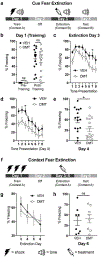Effects of N, N-Dimethyltryptamine on Rat Behaviors Relevant to Anxiety and Depression
- PMID: 29664276
- PMCID: PMC7196340
- DOI: 10.1021/acschemneuro.8b00134
Effects of N, N-Dimethyltryptamine on Rat Behaviors Relevant to Anxiety and Depression
Abstract
Depression and anxiety disorders are debilitating diseases resulting in substantial economic costs to society. Traditional antidepressants often take weeks to months to positively affect mood and are ineffective for about 30% of the population. Alternatives, such as ketamine, a dissociative anesthetic capable of producing hallucinations, and the psychoactive tisane ayahuasca, have shown great promise due to their fast-acting nature and effectiveness in treatment-resistant populations. Here, we investigate the effects of N, N-dimethyltryptamine (DMT), the principle hallucinogenic component of ayahuasca, in rodent behavioral assays relevant to anxiety and depression using adult, male, Sprague-Dawley rats. We find that while DMT elicits initial anxiogenic responses in several of these paradigms, its long-lasting effects tend to reduce anxiety by facilitating the extinction of cued fear memory. Furthermore, DMT reduces immobility in the forced swim test, which is a characteristic behavioral response induced by many antidepressants. Our results demonstrate that DMT produces antidepressant and anxiolytic behavioral effects in rodents, warranting further investigation of ayahuasca and classical psychedelics as treatments for depression and post-traumatic stress disorder.
Keywords: DMT; N,N-dimethyltryptamine; ayahuasca; depression; post-traumatic stress disorder; psychedelic.
Conflict of interest statement
The authors declare no conflict of interest.
Figures





References
-
- Gustavsson A, Svensson M, Jacobi F, Allgulander C, Alonso J, Beghi E, Dodel R, Ekman M, Faravelli C, Fratiglioni L, Gannon B, Jones DH, Jennum P, Jordanova A, Jönsson L, Karampampa K, Knapp M, Kobelt G, Kurth T, Lieb R, Linde M, Ljungcrantz C, Maercker A, Melin B, Moscarelli M, Musayev A, Norwood F, Preisig M, Pugliatti M, Rehm J, Salvador-Carulla L, Schlehofer B, Simon R, Steinhausen HC, Stovner LJ, Vallat JM, Van den Bergh P, van Os J, Vos P, Xu W, Wittchen HU, Jönsson B, and Olesen J (2011) Cost of disorders of the brain in Europe 2010. Eur Neuropsychopharmacol 21: 718–779. - PubMed
-
- Whiteford HA, Degenhardt L, Rehm J, Baxter AJ, Ferrari AJ, Erskine HE, Charlson FJ, Norman RE, Flaxman AD, Johns N, Burstein R, Murray CJ, and Vos T (2013) Global burden of disease attributable to mental and substance use disorders: findings from the Global Burden of Disease Study 2010. Lancet 382: 1575–1586. - PubMed
-
- Rush AJ, Trivedi MH, Wisniewski SR, Nierenberg AA, Stewart JW, Warden D, Niederehe G, Thase ME, Lavori PW, Lebowitz BD, McGrath PJ, Rosenbaum JF, Sackeim HA, Kupfer DJ, Luther J, and Fava M (2006) Acute and longer-term outcomes in depressed outpatients requiring one or several treatment steps: a STAR*D report. Am J Psychiatry 163: 1905–1917. - PubMed
-
- Berman RM, Cappiello A, Anand A, Oren DA, Heninger GR, Charney DS, and Krystal JH (2000) Antidepressant effects of ketamine in depressed patients. Biol Psychiatry 47: 351–354. - PubMed
-
- Ionescu DF, Swee MB, Pavone KJ, Taylor N, Akeju O, Baer L, Nyer M, Cassano P, Mischoulon D, Alpert JE, Brown EN, Nock MK, Fava M, and Cusin C (2016) Rapid and sustained reductions in current suicidal ideation following repeated doses of intravenous ketamine: Secondary analysis of an open-label study. J Clin Psychiatry 77: e719–725. - PubMed
Publication types
MeSH terms
Substances
Grants and funding
LinkOut - more resources
Full Text Sources
Other Literature Sources
Medical

